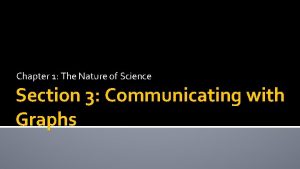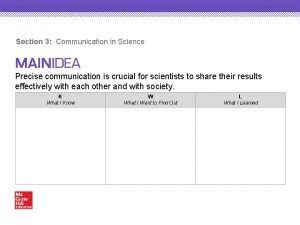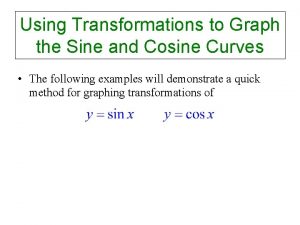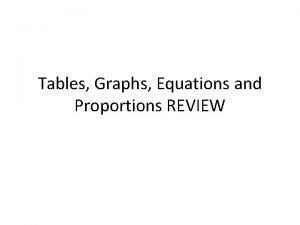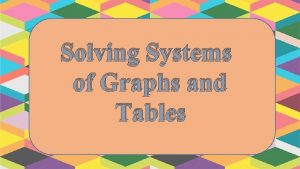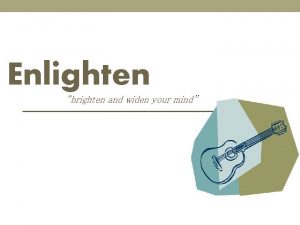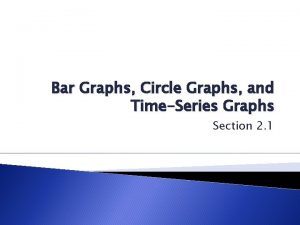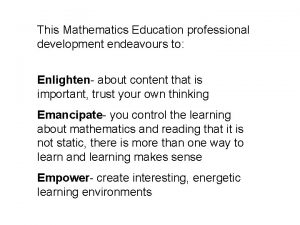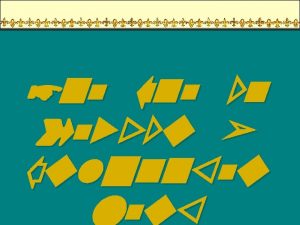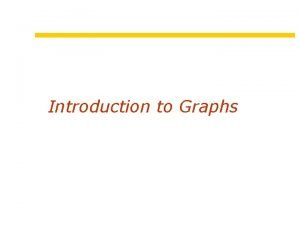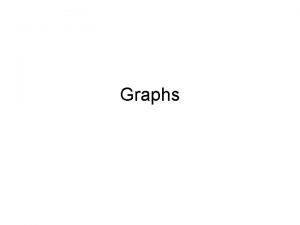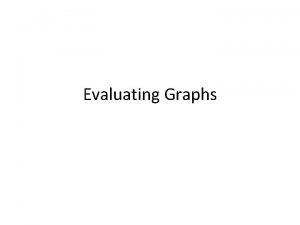SECTION 2 4 GRAPHS THAT ENLIGHTEN AND GRAPHS






























- Slides: 30

SECTION 2. 4 GRAPHS THAT ENLIGHTEN AND GRAPHS THAT DECEIVE

NEW GRAPH STYLES Pareto Graph Scatter Plots Dot Plots Stem Plots Pie Charts Ogive

PARETO CHARTS A bar graph where the bars are arranged in decreasing order.

PARETO CHARTS

SCATTERPLOTS A graph made by plotting ordered pairs.

SCATTERPLOTS

DOTPLOTS A graph in which each data value is plotted as a point (dot) along a horizontal scale of values.


STEMPLOTS Stemplot AKA stem-and-leaf plot Represents quantitative (continuous) data by separating each value into two parts: Stem - the left most digit Leaf - the right most digit


EXAMPLE Draw a stem plot given the data list 24, 52, 24, 50, 25, 26, 27, 32, 36, 27, 31, 48, 41, 31, 28, 36, 43, 32, 41, 45, 36

PIE CHARTS A graph that depicts categorical data as slices of circles, in which the size of each slice is proportional to the frequency.

PIE CHARTS

OGIVE Uses connected dots to depict the cumulative frequencies.

OGIVE

CREATE an OGIVE

GRAPHS THAT ENLIGHTEN Graphs that give a true understanding of the data.

GRAPHS THAT DECIEVE Graphs that mislead or contain errors.

To correctly interpret a graph, you must analyze the numerical information given in the graph, so as not to be misled by the graph’s shape. READ labels and units on the axes!

BAR GRAPH

Is This a Misleading Graph?

Note that the value for November (8. 6) has not been plotted correctly. It’s placed at the 9. 0 position. It’s been plotted to look like there’s a steep incline when in fact, the overall employment trend is pretty stable at around 9%.

WHAT IT SHOULD LOOL LIKE


WHAT IS WRONG WITH IT Only shows the first have of the year, when temperatures are always increasing.


WHAT IS WRONG WITH IT? The scale on this chart is fine. What Business Insider deduced from the chart is not. Have we “We have lost the ubiquitous positive financial return on education”? No. David Blake read the chart without taking into account a key fact that wasn’t on the chart: the cost of not going to college has diminished even more. Than means, your prospects as a high school graduate are a lot worse than your prospects as a college graduate.

WHAT IS WRONG WITH IT? Another key piece of information is Note the average yearly income a college grad can expect is about $45, 000 in 2010. That’s per year. Over an average working lifetime (say, 43 years assuming retirement at age 65), that gives you an income of $45, 000 * 43 = $1, 935, 000.

WHAT IS WRONG WITH IT? Another key piece of information is Subtract that expensive college education ($95, 000) and your net earnings are $1, 840, 000. Compare that to your average high school grad. They can expect to earn $1, 300, 000 over their lifetime (Source: The U. S. Department of Education). That’s quite a difference

 Graphs that enlighten and graphs that deceive
Graphs that enlighten and graphs that deceive Persuade inform entertain explain
Persuade inform entertain explain Contra harmonic mean filter
Contra harmonic mean filter Most high and glorious god
Most high and glorious god Ngoại tâm thu thất chùm đôi
Ngoại tâm thu thất chùm đôi Block xoang nhĩ là gì
Block xoang nhĩ là gì Thơ thất ngôn tứ tuyệt đường luật
Thơ thất ngôn tứ tuyệt đường luật Thơ thất ngôn tứ tuyệt đường luật
Thơ thất ngôn tứ tuyệt đường luật Chiến lược kinh doanh quốc tế của walmart
Chiến lược kinh doanh quốc tế của walmart Tìm vết của mặt phẳng
Tìm vết của mặt phẳng Con hãy đưa tay khi thấy người vấp ngã
Con hãy đưa tay khi thấy người vấp ngã Tôn thất thuyết là ai
Tôn thất thuyết là ai Gây tê cơ vuông thắt lưng
Gây tê cơ vuông thắt lưng Sau thất bại ở hồ điển triệt
Sau thất bại ở hồ điển triệt State graphs in software testing
State graphs in software testing Speed and velocity
Speed and velocity 5-3 practice polynomial functions
5-3 practice polynomial functions The nature of science section 3 communicating with graphs
The nature of science section 3 communicating with graphs Section 3 communicating with graphs answer key
Section 3 communicating with graphs answer key Section view example
Section view example Chemical potential energy images
Chemical potential energy images Revolved section drawing
Revolved section drawing Cutting view
Cutting view Chapter 10 section 1 meiosis answer key
Chapter 10 section 1 meiosis answer key Euler circuit
Euler circuit Tomer owns a daycare
Tomer owns a daycare Graph of sine and cosine functions
Graph of sine and cosine functions Tables graphs and equations
Tables graphs and equations Solving systems using tables and graphs
Solving systems using tables and graphs Linear quadratic exponential examples
Linear quadratic exponential examples Quadratic graphs roots and turning points
Quadratic graphs roots and turning points

















